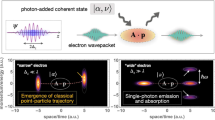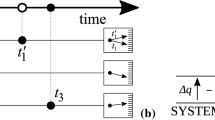Abstract
A proof is given of the Marshall-Santos conjecture of empirical compatibility, at low detector efficiencies, between quantum mechanics and local realistic theories. The enhancement phenomenon in the detection process is considered in a generalized Selleri-Zeilinger deterministic model, which reproduces the quantum-mechanical predictions for arbitrarily complicated EPR experimental arrangements.
Similar content being viewed by others
References
J. S. Bell,Physics 1, 195 (1965).
M. Ferrero and E. Santos,Phys. Lett. A 116, 356 (1986).
See: M. Ferrero, T. W. Marshall, and E. Santos, inQuantum Mechanics Versus Local Realism: The Einstein, Podolsky and Rosen Paradox, F. Selleri, ed. (Plenum, New York, 1988), p. 449.
F. Selleri and A. Zeilinger,Found. Phys. 18, 1141 (1988).
E. P. Wigner,Am. J. Phys. 38, 1005 (1970).
For a definition of the “weak” and “strong” inequalities, see: “History of the EPR paradox,” inQuantum Mechanics Versus Local Realism: The Einstein, Podolsky and Rosen Paradox, F. Selleri, ed. (Plenum, New York, 1988).
L. De Caro,Found. Phys. Lett. 2, 151 (1989); Erratum,Found. Phys. Lett. 2(5) (1989).
L. De Caro, Thesis, University of Bari, 1988.
For an analysis of the K° − K or B° − B systems, see: D. Home, inQuantum Mechanics Versus Local Realism: The Einstein, Podolsky and Rosen Paradox, F. Selleri, ed. (Plenum, New York, 1988), pp. 133–147.
A. Garuccio, inProblems in Quantum Physics, L. Kostroet al., eds. (World Scientific, Singapore, 1989).
Author information
Authors and Affiliations
Additional information
1. Optical devices such as lenses, filters, etc., should not modify the quantum state of photon pairs in an important way in order to obey a theoretical description in terms of local theories; therefore I consider polarizers and retardation plates only.
2. It has implicity been assumed that retardations plates do not modify the values ofδ andε.
3. For simplicity it has been assumed thatη 1 =η 2 =η.
4. In perfect analogy, one can generalize the model for more complex experimental arrangements with many polarizers and wave plates at the same time; but, without losing in generality, one can limit to these examples in order not to complicate the formalism with a larger number of hidden variables.
5. Quantum mechanical predictions, with a second polarizer inserted on photon-1 trajectories, coincide numerically with the values of the first four fractional populations n4 (...).
6. The upper limit on the quantum efficiency of the photomultipliers, for the validity of MS theorem, is not 2/π, as in the MS conjecture, but 0.5 .
Rights and permissions
About this article
Cite this article
De Caro, L. Quantum mechanics versus local realism: compatibility for low detector efficiencies. Found Phys Lett 2, 487–497 (1989). https://doi.org/10.1007/BF00689815
Received:
Revised:
Issue Date:
DOI: https://doi.org/10.1007/BF00689815




